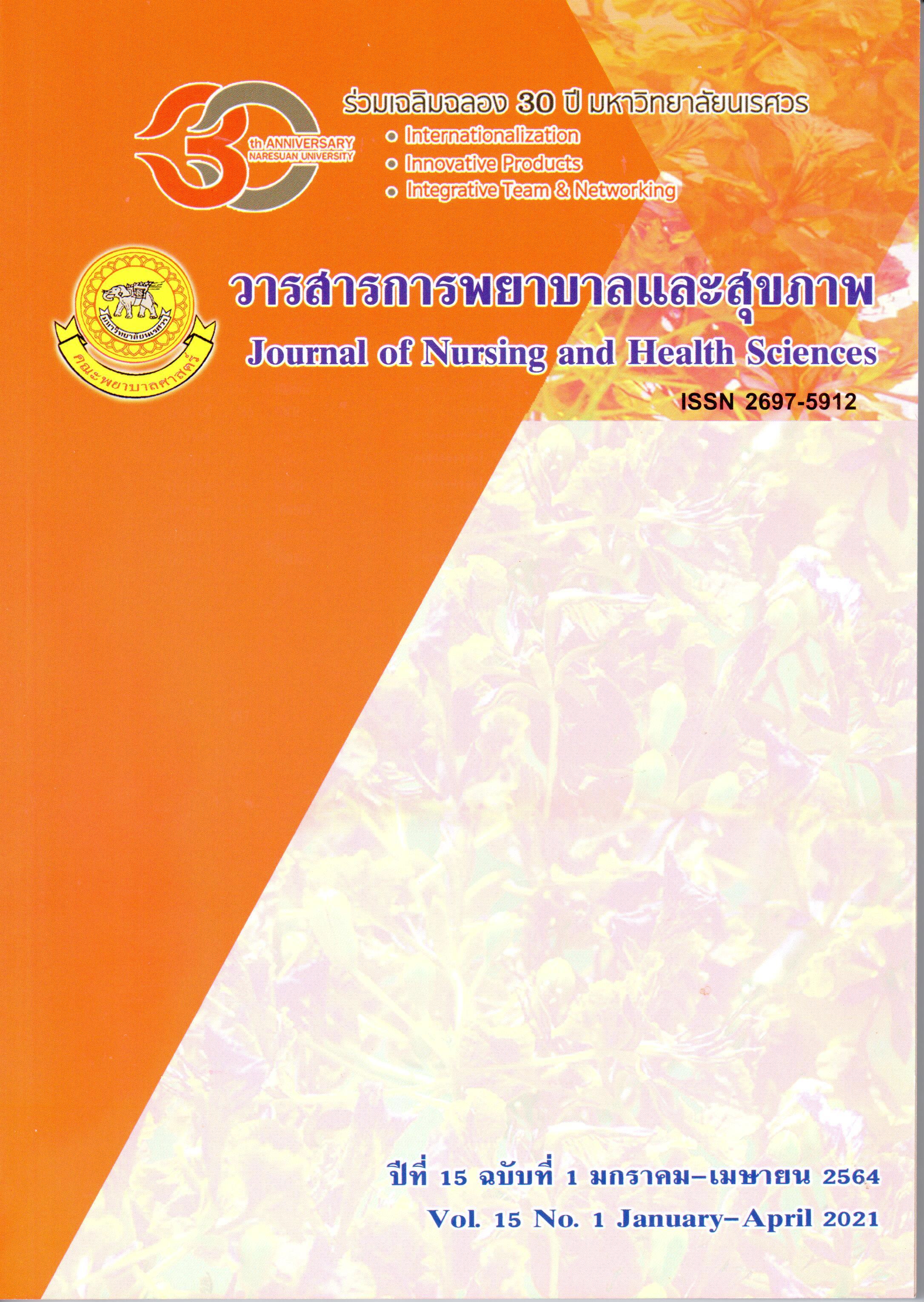ปัจจัยทำนายภาวะช็อกในผู้ป่วยอุบัติเหตุที่เข้ารับการรักษาในห้องอุบัติเหตุฉุกเฉิน
Main Article Content
บทคัดย่อ
การวิจัยนี้มีวัตถุประสงค์ เพื่อศึกษาปัจจัยทำนายภาวะช็อก ด้านอายุ ระดับการคัดแยกความรุนแรง ความรุนแรงของภาวะวิกฤต ประเภทการนำส่งโรงพยาบาล และระยะเวลาการบาดเจ็บจนถึงโรงพยาบาล ต่อภาวะช็อกของผู้ป่วยอุบัติเหตุ ที่เข้ารับการรักษาในห้องฉุกเฉิน โรงพยาบาลแพร่ เป็นการศึกษาความสัมพันธ์เชิงทำนาย (Predictive correlation research design) กลุ่มตัวอย่าง คือ ผู้ป่วยอุบัติเหตุที่เข้ารับการรักษาในห้องอุบัติหตุฉุกเฉิน จำนวน 200 ราย เก็บข้อมูลย้อนหลังจากแฟ้มข้อมูลของผู้ป่วย และแบบบันทึกเฝ้าระวังการเกิดอุบัติเหตุ ระหว่างเดือนพฤศจิกายน 2562-เมษายน 2563 เครื่องมือที่ใช้ในการวิจัย ได้แก่ แบบบันทึกข้อมูลส่วนบุคคล เครื่องมือการคัดแยกระดับความรุนแรง (Emergency severity index ; ESI) แบบประเมินความรุนแรงของภาวะวิกฤต (Rapid emergency medicine score; REMS) และแบบประเมินดัชนีภาวะช็อก (Shock Index; SI) วิเคราะห์ข้อมูลโดยใช้สถิติ t-test, Wilcoxon Rank sum test และ Binary logistic regression analysis กำหนดระดับนัยสำคัญที่ .05 พบว่า กลุ่มตัวอย่างส่วนใหญ่เป็นเพศชาย ร้อยละ 65.6 มีอายุเฉลี่ย 48.2ปี (SD=18.4) การบาดเจ็บส่วนใหญ่เป็นอุบัติเหตุจราจร ร้อยละ 48.5 เข้าถึงโรงพยาบาลโดยมาเอง ร้อยละ 37.0 ระยะเวลาตั้งแต่เกิดเหตุจนถึงโรงพยาบาลนานกว่า 60 นาที (63.0%) ผู้ป่วยมีภาวะช็อกร้อยละ 54.5 (SI > 0.7) อายุ ระดับความรุนแรงของผู้ป่วย ณ จุดคัดแยก (ESI triage level) และประเภทการนำส่งโรงพยาบาลมี
ความสัมพันธ์กับภาวะช็อก (p = < .001, .001, .037) วิเคราะห์อำนาจการทำนาย พบว่า อายุมากกว่า 60 ปี ลดโอกาสเสี่ยงต่อภาวะช็อก (OR=.317, 95% CI= .13-.79) ระดับความรุนแรงของ ESI triage level 1 และ level 2 เพิ่มความเสี่ยงต่อการมีภาวะช็อก 7.7 เท่า (95% CI= 2.17-27.20) และ 3.39 เท่า (95% CI= 1.18-10.07) ตามลำดับ
Article Details

อนุญาตภายใต้เงื่อนไข Creative Commons Attribution-NonCommercial-NoDerivatives 4.0 International License.
เอกสารอ้างอิง
Allgower, M., & Buri, C. (1967). Schock index. Dtsch Med Wochenschr Journal, 92. 1947-1950.
Al-Shaqsi, S. (2010). Model of international emergency medical service (EMS) systems. Oman Med Journal, 25. 319-323.
Brown, J.B., Gestring, M.L., Forsythe, R.M., Stassen, N.A., Billiar, T.R., Peithman, A.B., & Sperry, J.L. (2015). Systolic blood pressure criteria in the National Trauma triage protocol for geriatric trauma: 110 is the new 90. Journal Trauma Acute Care Surg, 78. 352-359.
Carlson, B., & Fitzsimmons, L. (2014). Shock, sepsis, and multiple organ dysfunction syndrome. In Urden, L. D., Stacy, K. M., & Lough, M. E. (Eds.), Critical care nursing: Diagnosis and management (pp. 887-925) (7th ed.). Mosby: Elsevier.
Faul, F., Erdfelder, E., Bunchner, A., & Lang, A.G. (2013). G* Power version 3.1.7.9.2 [computer software]. Retrieved 19 October 2017 from: http://www.statisticsolution. com//logistic-regression-2-2-tailed.
Gilboy, N., Tanabe, P, Travers, D., & Rosenau, A.M. (2012). Emergency severity index (ESI). A triage tool for emergency department care version 4. Implement handbook 2012. (4thed). Rockville: Agency for Healthcare Research and Quality.
Glunkwamdee, N., Thosingha, O., Danaidussadeekul, S., & Praditsuktavorn, B. (2015). Factors related to land traffic accident injury victims’ access to medical care. Thai Journal of Nursing Council, 30(3), 54-66.
Hansudewechakul, N, Chenthanakij, B., & Wittayachamnankul, B. (2012). Why don’t Chiang Mai people in need call emergency medical service. Journal of Health Science, 6(2), 268-77.
Harmsen, A.M.K, Giannakapoulos, G.F., Morebeek, P.R., Jansma, E3P., Bonjer, H.J., & Bloemers, F.W. (2015). The influence of prehospital time on trauma patients outcome: a systematic review. Injury, 46. 602-609.
Hasadsree, N., Chanruangvanich, W., Thosingha O., & Riyapan S., (2019). Factors predicting shock in emergency patients. Journal of Thailand Nursing and Midwifery Council, 34 (3). 60 – 75. [In Thai].
Hasler, R.M., Nuesch, E., Juni, P., Bouamra, O., Exadaktylos, A.K., & Lecky, F. (2011). Systolic blood pressure below 110 mmHg is associated with increased mortality in blunt major trauma patients: multicentre cohort study. Resuscitation, 82. 1202-1207.
Holler, J.G., Henriksen, D.P., Mikkelsen, S., Rasmussen, L.M., Pedersen, C., & Lassen, A.T. (2016). Shock in the emergency department: a 12 year population based cohort study. Scandinavian journal trauma resuscitation emergency medicine, 87. 1-11.
Imhoff, B. F., Thompson, N. J., Hastings, M. A., Nazir, N., Moncure, M., & Cannon, C. M. (2014). Rapid emergency medicine score (REMS) in the trauma population: a retrospective study. BMJ Open, 4(5). doi: 10.1136/bmjopen-2013-004738.
Katsakun, A., Thosingha, O., Chayaput, P., & Chaotawee, D. (2011). Factors predicting injury outcome in emergent phase among adults with traumatic injuries. Thai Journal of Nursing Council, 26(4), 30-42.
Koch, E., Lovett, S., Nghiem, T., Riggs, R. A., & Rech, M. A. (2019). Shock index in the emergency department: utility and limitations. Open access emergency medicine: OAEM, 11, 179.
Lin, M. W., Wu, C. Y., Pan, C. L., Tian, Z., Wen, J. H., & Wen, J. C. (2017). Saving the on-scene time for out-of-hospital cardiac arrest patients: The registered nurses’ role and performance in emergency medical service teams. BioMed research international.
Llompart-Pou, J.A., Perez-Barcena, J., Chico-Fernandez, M., Sanchez-Casado, M., & Raurich, J.M. (2017). Severe trauma in the geriatric population. World Journal Crit Care Med, 6. 99-106.
McNab, A., Burns, B., Bhullar, I., Chesire, D., & Kerwin, A. (2012). A prehospital shock index for trauma correlates with measures of hospital resource use and mortality. Surgery, 152(3), 473-476.
Mirhaghi, A., Kooshiar, H., Esmaeili, H., & Ebrahimi, M. (2015). Outcomes for emergency severity index triage implementation in the emergency department. Journal of clinical and diagnostic research: JCDR, 9(4), OC04.
National Institute of Emergency Medicine. (2017). Annual report 2559: Nonthaburi: National Institute of Emergency Medicine, 36. [In Thai].
Platts‐Mills, T. F., Travers, D., Biese, K., McCall, B., Kizer, S., LaMantia, M., ... & Cairns, C. B. (2010). Accuracy of the emergency severity index triage instrument for identifying elder emergency department patients receiving an immediate life‐saving intervention. Academic Emergency Medicine, 17(3), 238-243.
Rady, M.Y., Nightingale, P., Little, R.A, & Edwards, J.D. (1992). Shock Index: a re-evaluation in acute circulatory failure. Resuscitation, 23. 227-234.
Wilmot, L.A. (2010). Shock: early recognition and management. Emergency Nursing Journal, 36. 134-139.
World Health Organization. (2015). Global status report on road safety 2015. Retrieved from WHO library cataloguing-in-publication data. Geneva,1. 12-30.


